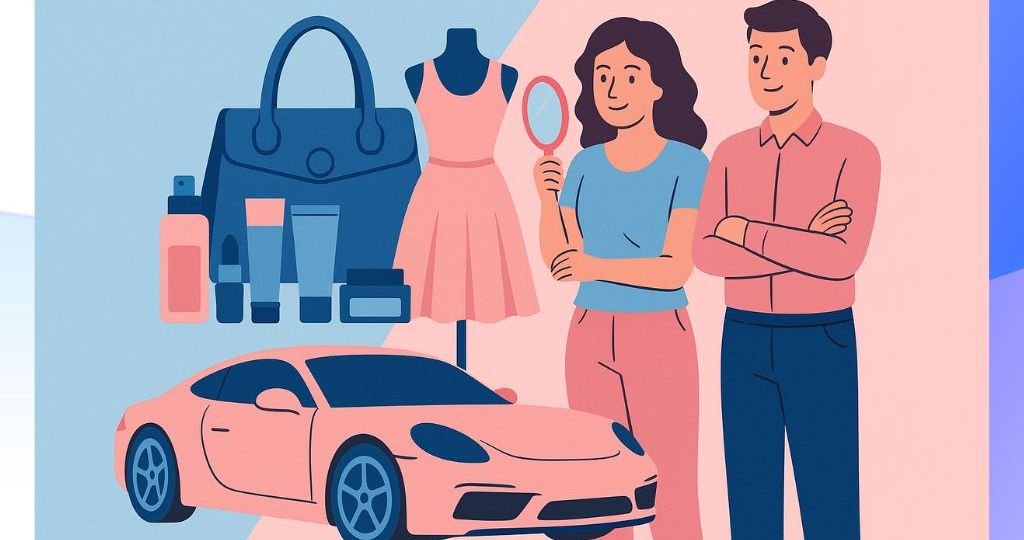
In fashion, cosmetics, or the automotive industry, consumption is never a purely functional act. These domains are not limited to products — they express systems of signs and values where questions of status, recognition, and social belonging are at play. Wearing a luxury watch, choosing a rare perfume, or driving a high-end car is not just about satisfying a practical need; it reflects a way of existing in the eyes of others and signifies one’s place in a broader social space.
For a Business Analyst, understanding these symbolic logics is essential. Beyond data, dashboards, and performance indicators, the goal is to decode the deeper motivations: the need for distinction, the quest for legitimacy, or attachment to a cultural identity.
This is where ostentatious consumption and habitus become powerful analytical tools. Together, they allow consumption to be interpreted as a social language — revealing how individuals assert their position, express their tastes, and negotiate their belonging to a group.
By mobilizing the concepts of ostentatious consumption and habitus, the Business Analyst can move beyond purely economic approaches to understand what each purchase decision says about the relationship between culture, status, and innovation.
1. Veblen and Ostentatious Consumption: Understanding the Logic of Prestige in the Customer Experience
In The Theory of the Leisure Class (1899), Thorstein Veblen explains that some consumers do not buy a product for its mere utility, but to show that they can afford it. The act of purchase thus becomes a tool of social distinction.
In this logic, possession is not only consumption — it is communication of status, belonging, and success.
Why This Is Essential for a Business Analyst
In sectors where brand image and social perception dominate — such as fashion, cosmetics, automobiles, and even high-end digital products — this logic directly influences purchasing decisions, user behaviors, and expectations regarding customer experience.
Sectoral Examples
Fashion: A designer handbag or a luxury watch is chosen not for its function, but for the symbolic value of the logo and access to an elite circle.
Cosmetics: A Dior lipstick or a La Mer cream becomes a marker of social recognition, a visible sign of a certain lifestyle.
Automobile: Owning a Ferrari, a Porsche, or a Tesla Plaid is a way to display professional success and access to an exclusive world.

💡 Business Analysis / IT Product Management Perspective
For a Business Analyst or Product Manager, Veblen’s theory invites reflection on the symbolic dimension of every feature or product offering:
Identify user segments motivated by visibility or prestige.
Design differentiated digital journeys: VIP badges, personalized experiences, limited editions, or premium interfaces.
Track image-related KPIs: adoption of high-end versions, use of customization options, social sharing rates, or engagement with status-enhancing products.
In short, Veblen reminds Business Analysts that a product does not only have use value — it also carries a value of distinction, which must be detected, measured, and translated into product strategy.
2. Bourdieu and the Habitus: Understanding the Cultural Logic Behind User Behaviors

In Distinction (1979), Pierre Bourdieu demonstrates that our tastes, habits, and even consumption choices are not merely individual preferences but reflect our cultural, economic, and social capital.
He calls habitus this set of internalized dispositions — acquired through education, social environment, and life experience — that guide our behavior without our full awareness.
Where Veblen emphasizes the performance of prestige, Bourdieu focuses on cultural coherence: each social group develops a specific relationship to objects, beauty, technology, and their modes of use.
Why This Is Essential for a Business Analyst
In digital product design, understanding habitus means recognizing that not all users value the same criteria: some seek practicality, others rarity; some prefer simplicity, others sophistication.
It is a key to refining segmentation, personalizing experiences, and anticipating implicit needs.
Sectoral Examples
Fashion:
Popular habitus → attachment to functionality and fair price.
Bourgeois habitus → preference for understated elegance and artisanal quality.
Cosmetics:
Popular habitus → simple routines, accessible brands, visible effectiveness.
Bourgeois habitus → attraction to brand heritage, rarity, and craftsmanship.
Automobile:
Popular habitus → search for reliability, safety, and economy.
Bourgeois habitus → quest for discreet prestige and sophisticated comfort.
💡 Business Analysis / Product Strategy Perspective
For a Business Analyst, habitus becomes a strategic interpretive tool for customer data:
Go beyond economic variables (age, income, location) to integrate users’ cultural and symbolic capital.
Create socio-cultural personas that capture differences in taste, language, and social legitimacy.
Adapt functional design:
- A car app can offer both a “fuel-saving mode” for pragmatic users
- and a “prestige mode” with premium services or personalized experiences for those seeking distinction.
In other words, Bourdieu reminds us that understanding usage means understanding context: the same product can be perceived differently depending on the habitus of its user.
This interpretive capacity is where the true value of a human-centered Business Analyst lies.
3. The Cleft Habitus: Understanding Consumption Under Tension and Hybrid Behaviors
The cleft habitus describes the situation of an individual torn between the dispositions inherited from their social origins and the new norms adopted through professional success, education, or social mobility.
This tension, central to modern societies, translates into ambivalent consumption: aspiring to prestigious worlds while remaining attached to prudence and economic rationality.
In other words, the cleft habitus is consumption between two worlds — one’s origins and one’s success.
For a Business Analyst, it provides a powerful key to understanding mixed behaviors and apparent contradictions among users.
Sectoral Examples
Fashion: A young consultant buys a Louis Vuitton bag to signal success but continues to shop at Zara out of habit and rationality.
Cosmetics: An executive chooses a Guerlain perfume for meetings but remains loyal to mass-market products daily.
Automobile: A socially mobile manager drives an Audi or Tesla — symbols of prestige and innovation — while keeping a modest family car for daily commutes.
These behaviors reflect a search for balance between self-affirmation and image control, between the desire for recognition and loyalty to one’s roots.
💡 Business Analysis / Product Management Perspective
The cleft habitus invites Business Analysts to rethink segmentation: users are not fixed in a single social or economic category but move between multiple consumption identities.
This opens several operational paths:
Offer hybrid products combining accessibility and prestige: “affordable luxury” lines, discovery formats, or à-la-carte premium services.
Design inclusive user journeys, allowing users to shift between rationality and symbolic value — e.g., an “eco” mode and a “premium” mode within the same app.
Measure behavioral hybridization through indicators such as:
proportion of mixed carts (mass-market + premium products),
differentiated service use by context (work vs. leisure),
feature combinations valuing both price and prestige.
👉 For the Business Analyst, the cleft habitus is a strategic indicator revealing the emotional and social complexity behind purchasing decisions.
It also signals opportunities for product design, as these “in-between” users are often the most receptive to balanced experiences — between performance and aspiration, functionality and symbolism.
4. Contrasting Personas: From Distinction to Social Duality
Personas are not merely demographic profiles — they embody cultural dispositions, values, and often unconscious consumption logics.
For the Business Analyst, integrating Veblen’s and Bourdieu’s concepts into persona creation means going beyond who the users are to understand why they behave as they do.
👩💼 Emma, 29 — The Cleft Habitus in Motion
A young marketing executive from a modest background, Emma perfectly illustrates the tension of social mobility.
In her daily life, she balances aspiration and prudence: her designer bag symbolizes the success she wants to affirm, while her purchasing habits reflect her attachment to rationality and simplicity.
Emma is not just consuming — she is legitimizing her success without betraying her authenticity.
💡 Business Analyst / Product Designer Perspective
Design accessible premium ranges combining quality and affordability.
Integrate socially rewarding features (badges, experience sharing, customer storytelling) to reinforce belonging.
Develop balanced communication that celebrates success without ostentation.
Emma represents a strategic, often underestimated segment: aspirational consumers seeking balance between social mobility and cultural loyalty.
👨💼 Alexandre, 34 — The Elitist Habitus and Cultural Coherence
Coming from a cultivated, affluent background, Alexandre embodies the continuity of a bourgeois habitus where taste is defined by restraint, quality, and culture.
He favors niche perfumes, artisanal watches, and understated luxury cars. For him, luxury is not a show — it is a cultivated habit.
💡 Business Analyst / Product Strategist Perspective
Emphasize discreet exclusivity through minimalist design, heritage storytelling, and private experiences.
Build user journeys focused on mastery, personalization, and rarity.
Highlight durability and coherence rather than flashy novelty.
Alexandre represents a more stable but essential segment for understanding heritage and cultural continuity in consumption.
Conclusion: From Sociology to Product Strategy
Consumption choices in fashion, cosmetics, and automobiles are never purely rational — they reflect social, cultural, and symbolic dynamics.
Understanding these logics means understanding how ostentatious consumption and habitus shape the way individuals express themselves through brands, objects, and experiences.
Thorstein Veblen shows that consumption can be a language of prestige and recognition, while Pierre Bourdieu reveals how habitus and distinction structure our tastes, practices, and aspirations according to social position.
Finally, the concept of the cleft habitus sheds light on the identity tensions experienced by those navigating between two worlds: loyalty to origins and transformation through success.
👉 For a Business Analyst or Product Manager, these frameworks are not just theoretical — they offer genuine strategic insight into customer behavior.
They help decode the deeper motivations behind purchasing decisions.
They enable the creation of culturally grounded personas beyond mere economic segmentation.
They inspire inclusive product strategies that speak to both reason and emotion.
And they help anticipate market transformations shaped by the desire for prestige, the need for coherence, and the search for authenticity.
Thus, ostentatious consumption and habitus are not mere sociological concepts — they are strategic tools for understanding perceived value, user behavior, and evolving expectations in digital ecosystems.
Business Analysis is not just a technical discipline — it is a cultural analysis of meaning, a way to interpret behaviors at the intersection of the social, digital, and emotional realms.
And it is precisely in this perspective that ostentatious consumption and habitus become essential levers of understanding for digital transformation professionals.

With an academic background dedicated to the study of habitus and hands-on experience in Business Analysis, I explore how data, usage, and cultural values intersect in product design.
👉 Join me on 32steps.com to discover how sociology can enrich business and digital strategy.
You may also like: “ Business Scenarios vs Test Cases: What’s the Difference ?”
Feel free to share this article on your social networks.
If you have any questions, contact us by email — we’ll be happy to respond.
Follow our Pinterest page for visual inspiration and new ideas.


